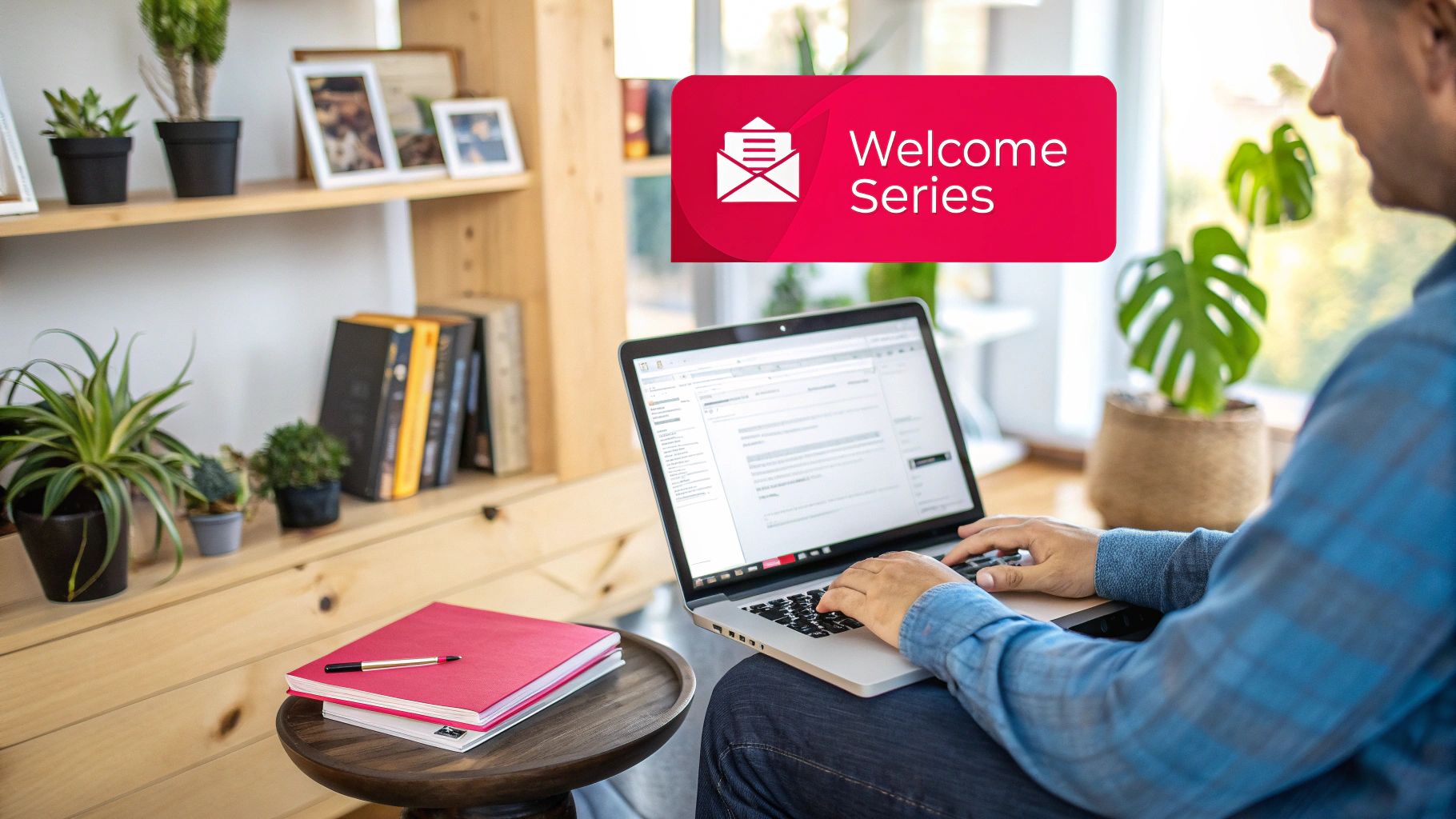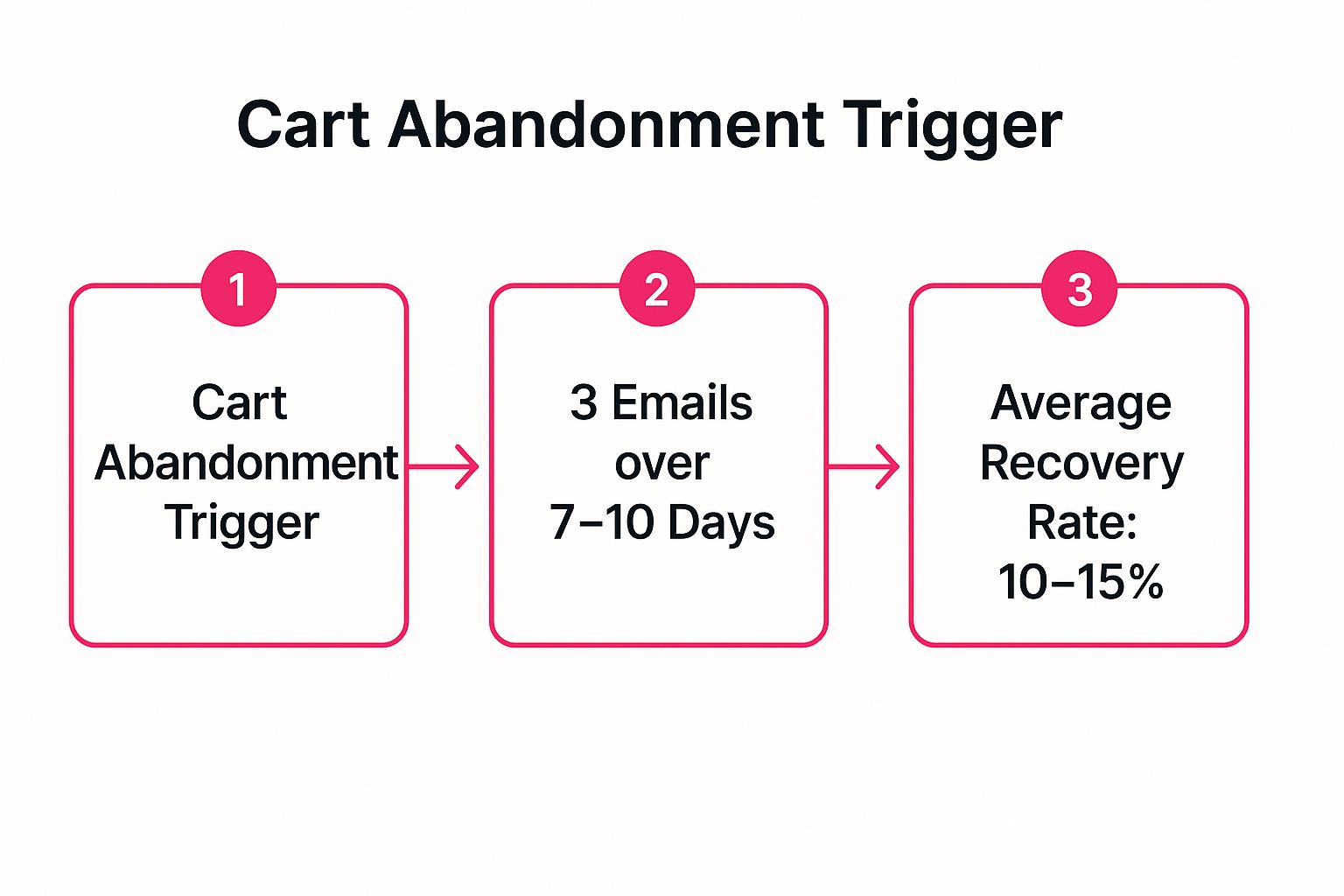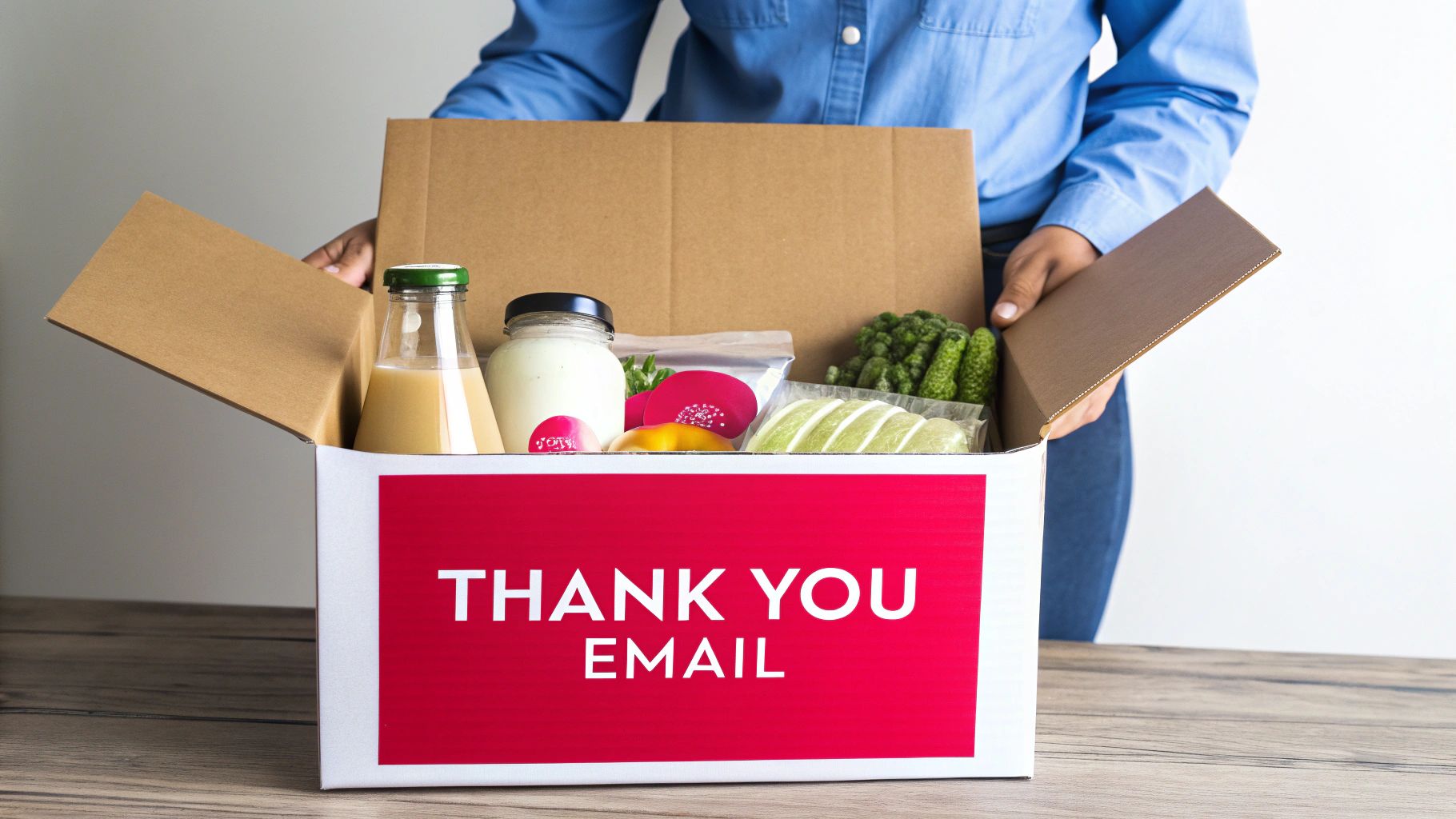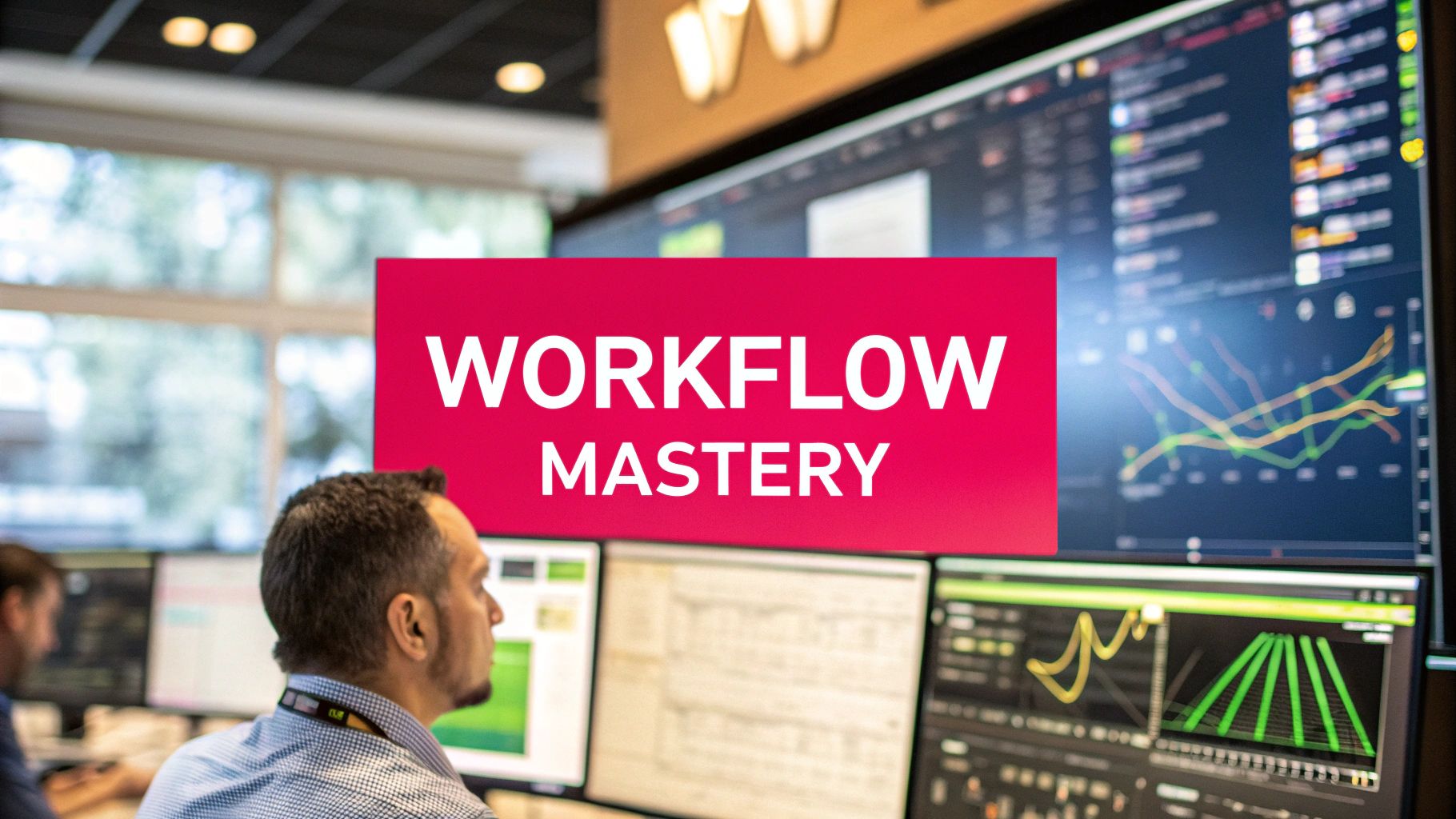Unlocking Growth: Why Smart Automation is Your Secret Weapon
Modern marketers, particularly in a competitive hub like Dubai, face constant pressure to deliver more impactful results with finite resources. The solution isn't just working harder; it's working smarter. This is where marketing automation transcends being a simple tool and becomes a strategic framework for building scalable, personalised customer journeys that drive real growth. It allows you to engage with the right person, with the right message, at precisely the right moment, without manual intervention.
This article moves beyond theory to provide seven detailed, replicable marketing automation workflow examples. Forget generic advice. We will break down each workflow into its essential components:
- The Trigger: What action starts the automation?
- The Goal: What is the desired business outcome?
- The Steps: A clear, sequential blueprint of the journey.
- The Metrics: How to measure success effectively.
These blueprints are designed for immediate implementation, whether you're a startup founder, an e-commerce retailer, or a B2B company in the UAE aiming to enhance lead generation. They represent the kind of customised strategies specialist firms use to deliver measurable outcomes. For a deeper dive into practical applications and further inspiration, you can also explore more marketing automation workflow examples to broaden your tactical library. Let's explore these powerful workflows.
1. Welcome Email Series
A Welcome Email Series is a foundational marketing automation workflow designed to engage new subscribers or customers from the moment they join your list. More than a single "thank you" email, this automated sequence of 3-7 messages is sent over 7-14 days to introduce your brand, set expectations, and guide users towards a specific action. It is one of the most powerful marketing automation workflow examples because it capitalises on the high engagement rates of new subscribers, turning initial curiosity into lasting loyalty.

The primary goal is to build a relationship, not just push a sale. For instance, Airbnb's welcome series for new hosts doesn’t just say "welcome"; it walks them through the essential steps of creating a successful listing. Similarly, Duolingo sends a sequence of motivational emails to help new users form a consistent language-learning habit. This approach establishes trust and demonstrates value immediately.
Strategic Analysis and Application
This workflow is essential for any business that relies on email lists for lead nurturing, customer onboarding, or e-commerce sales. It automates the crucial first impression, ensuring every new contact receives a consistent, high-quality introduction to your brand.
- Trigger: A user subscribes to a newsletter, creates an account, or makes their first purchase.
- Goal: To convert a new subscriber into an engaged community member or a repeat customer.
- Key Steps:
- Email 1 (Immediate): Deliver the promised value (e.g., discount code, e-book) and warmly welcome them.
- Email 2 (Day 2-3): Introduce your brand’s story, mission, or unique value proposition.
- Email 3 (Day 4-5): Showcase social proof like testimonials or best-selling products to build credibility.
- Email 4 (Day 7+): Segment users based on their initial engagement (clicks, opens) and send targeted follow-up content.
- Performance Metrics: Open rates, click-through rates (CTR), conversion rates (e.g., first purchase), and unsubscribe rates.
Actionable Takeaways
To implement an effective welcome series, focus on personalisation and value. Keep the first email simple and centred on delivering what was promised. Space subsequent emails 2-3 days apart to maintain engagement without overwhelming the user’s inbox. Critically, segment your audience based on their signup source; a user who signed up for a webinar needs a different message than one who downloaded a case study. For more inspiration, you can explore other powerful email marketing examples to refine your strategy.
2. Abandoned Cart Recovery
An Abandoned Cart Recovery workflow is a critical e-commerce automation designed to re-engage customers who add items to their shopping cart but leave without completing the purchase. This automated sequence of emails or messages is triggered by the abandonment event, aiming to recover potentially lost sales. It's one of the highest-return marketing automation workflow examples because it targets users with clear purchase intent, reminding them of their items and addressing common barriers to purchase like shipping costs or technical issues.
This infographic illustrates the standard process flow for a cart recovery sequence.

The data highlights a typical multi-email strategy deployed over several days, which successfully recovers a significant percentage of otherwise lost revenue. For instance, Amazon's system sends timely reminders, while a fashion retailer like ASOS uses personalised recommendations in its recovery emails. These workflows are highly effective at turning hesitation into a completed transaction.
Strategic Analysis and Application
This workflow is indispensable for any e-commerce business, from startups to large enterprises. It directly impacts the bottom line by recapturing revenue that would otherwise be lost. Platforms like Shopify and WooCommerce have popularised this by making it easy to implement, ensuring businesses can automatically follow up on every abandoned cart.
- Trigger: A logged-in user or guest with an email on file adds a product to their cart but does not complete the checkout process within a set time (e.g., 30-60 minutes).
- Goal: To recover the sale by reminding the customer of the cart's contents and persuading them to complete the purchase.
- Key Steps:
- Email 1 (1-3 Hours): A gentle reminder with a subject line like "Did you forget something?". Include images of the cart items.
- Email 2 (24 Hours): Create urgency or offer assistance. Address potential questions about shipping or returns.
- Email 3 (3-5 Days): Offer a small incentive, such as a limited-time discount or free shipping, to prompt a final decision.
- Performance Metrics: Cart recovery rate, conversion rate from recovery emails, average order value (AOV) of recovered carts, and unsubscribe rates.
Actionable Takeaways
To maximise recovery rates, timing and content are crucial. Send the first email within an hour of abandonment to catch the user while the purchase is still top-of-mind. Use compelling, high-quality images of the products left behind. Critically, A/B test your incentives; sometimes, a simple offer of help is more effective than a discount. Always include clear contact information or links to your support page to remove any final barriers. For a deeper dive into improving your online store's performance, explore these additional e-commerce strategies.
3. Lead Nurturing Drip Campaign
A Lead Nurturing Drip Campaign is a strategic sequence of automated communications designed to build relationships with prospects over time. This workflow moves beyond a simple welcome by providing valuable, relevant content that guides potential customers through the sales funnel. It is one of the most critical marketing automation workflow examples for B2B and high-consideration B2C products, as it systematically cultivates trust and educates leads until they are ready to make a purchase decision.
The core principle, popularised by inbound marketing pioneers like HubSpot, is to serve the right content to the right person at the right time. Instead of an immediate hard sell, this workflow focuses on addressing a prospect's pain points and questions. For example, a software company might send a series of emails that start with a high-level industry report, followed by a detailed case study, and finally an invitation for a personalised demo. This gradual process ensures leads are qualified and well-informed before they ever speak to a sales representative.
Strategic Analysis and Application
This workflow is indispensable for businesses with longer sales cycles, where immediate conversion is unlikely. It automates the crucial "middle-of-the-funnel" stage, keeping your brand top-of-mind and positioning it as a helpful authority.
- Trigger: A user downloads a gated asset (e.g., e-book, whitepaper), signs up for a webinar, or requests more information.
- Goal: To convert a marketing qualified lead (MQL) into a sales qualified lead (SQL) ready for direct engagement.
- Key Steps:
- Initial Contact (Immediate): Deliver the requested asset and set the stage for what’s to come.
- Educational Content (Days 3-5): Send content related to the initial download, addressing a broader problem (e.g., a blog post or video).
- Solution-Focused Content (Days 7-10): Introduce your product or service as a potential solution with case studies or testimonials.
- Conversion Offer (Days 12-15): Present a clear call-to-action (CTA) like a consultation, demo, or trial offer.
- Re-engagement or Sales Handoff: Based on engagement (clicks, page visits), either move the lead to a sales pipeline or place them in a long-term, low-frequency nurture track.
- Performance Metrics: Lead score progression, MQL-to-SQL conversion rate, content engagement rates (CTR, downloads), and ultimately, sales cycle length.
Actionable Takeaways
To build an effective lead nurturing campaign, you must map your content to the specific stages of the buyer's journey. Use lead scoring to track engagement and prioritise high-value prospects for your sales team. A key tactic is progressive profiling, where you use forms to gather small pieces of information over time, enriching your contact data without creating friction. Always include a clear next-step CTA in every communication. For more in-depth strategies, you can review these proven lead nurturing campaign examples to inspire your own workflow.
4. Win-Back Campaign
A Win-Back Campaign is an automated workflow designed to re-engage inactive customers or subscribers who have not interacted with your brand for a specified period. Instead of letting dormant contacts clutter your list, this sequence uses targeted messaging and incentives to reignite their interest. This is a crucial one of the marketing automation workflow examples because it is often more cost-effective to retain an existing customer than to acquire a new one. It helps recover potentially lost revenue and cleans your contact list.
The goal is to remind users of the value they once found in your brand and give them a compelling reason to return. For instance, Netflix's classic "We miss you" emails often showcase new, trending shows based on a user's past viewing history. Similarly, Starbucks will send rewards-based reactivation offers, like bonus stars for a purchase, to lapsed members of their loyalty programme, directly incentivising a return visit.
Strategic Analysis and Application
This workflow is invaluable for subscription services, e-commerce stores, and any business model reliant on repeat customer engagement. It automates the process of identifying and re-engaging at-risk segments of your audience, preventing churn before it becomes permanent. A well-executed win-back campaign can significantly boost customer lifetime value.
- Trigger: A contact has not opened an email, logged into their account, or made a purchase for a predefined period (e.g., 60-90 days).
- Goal: To reactivate a dormant user, prompting them to make a purchase, log in, or re-engage with email content.
- Key Steps:
- Email 1 (Gentle Nudge): Send a friendly "We miss you" email. Remind them of the benefits of being a customer or subscriber.
- Email 2 (Incentive): Present an exclusive, time-sensitive offer, such as a special discount, free shipping, or a bonus gift.
- Email 3 (Feedback/Survey): If there is still no response, ask for feedback. A simple survey can provide valuable insight into why they became inactive.
- Email 4 (Last Chance/Unsubscribe): Inform them this will be the last email and give them an easy option to unsubscribe. This maintains list hygiene and respects their inbox.
- Performance Metrics: Re-engagement rate (opens/clicks from the inactive segment), conversion rate (from the offer), customer churn rate reduction, and feedback response rate.
Actionable Takeaways
To build an effective win-back campaign, timing and tone are critical. Start the sequence after a significant period of inactivity, typically 60-90 days, to avoid seeming pushy. Use nostalgic or curiosity-piquing subject lines that reference their past relationship with your brand. The offer should feel exclusive and valuable enough to prompt action. Finally, always provide a clear and easy path to unsubscribe; this builds trust and ensures you maintain a high-quality, engaged email list.
5. Post-Purchase Follow-Up
A Post-Purchase Follow-Up is an automated email or messaging sequence triggered immediately after a customer completes a transaction. Far more than a simple receipt, this workflow is designed to reassure the customer, build excitement, and nurture the relationship beyond the initial sale. It transforms a one-time purchase into the beginning of a long-term customer journey by providing value through order confirmations, shipping updates, and helpful product tips. This is one of the most crucial marketing automation workflow examples for e-commerce, as it directly impacts customer satisfaction and lifetime value.

The core purpose is to reduce post-purchase anxiety and reinforce the customer's decision. For example, Apple sends a series of emails after a Mac purchase, offering setup guides and feature tutorials to ensure a smooth onboarding experience. Similarly, Zappos excels with its proactive communication, sending order, shipping, and delivery confirmations, followed by a satisfaction check-in. This level of care makes customers feel valued and supported, encouraging future loyalty.
Strategic Analysis and Application
This workflow is indispensable for any business selling products or services online, from e-commerce retailers to SaaS companies. It automates the post-sale experience, ensuring every customer feels acknowledged and supported, which is vital for building brand trust and encouraging repeat business.
- Trigger: A customer completes a purchase or places an order.
- Goal: To increase customer satisfaction, reduce buyer's remorse, and drive repeat purchases and reviews.
- Key Steps:
- Email 1 (Immediate): Send an order confirmation with a detailed receipt and a thank you message.
- Email 2 (On Shipment): Provide a shipping confirmation with a tracking link and estimated delivery date.
- Email 3 (Post-Delivery): Offer product usage tips, care instructions, or links to helpful resources.
- Email 4 (7-14 Days Post-Delivery): Request a product review or feedback on their shopping experience.
- Email 5 (30+ Days Post-Purchase): Send a personalised follow-up with related product recommendations based on their purchase.
- Performance Metrics: Repeat purchase rate, customer lifetime value (CLV), product review submission rate, and customer support ticket volume.
Actionable Takeaways
To create a powerful post-purchase flow, focus on timeliness and relevance. The initial order confirmation should be sent within minutes of the transaction. Personalise content by including specific product details, like sending Patagonia's care instructions for a specific jacket. Critically, time your review request appropriately; give the customer enough time to actually use the product before asking for their opinion. By automating this communication, you create a seamless and reassuring experience that turns first-time buyers into brand advocates.
6. Birthday and Anniversary Campaigns
A Birthday and Anniversary Campaign is an automated workflow that sends personalised messages and offers to customers on significant dates like their birthday or the anniversary of their first purchase. This strategy leverages personal milestones to create a moment of delight, strengthening the emotional connection between the customer and the brand. This is a highly effective entry in our list of marketing automation workflow examples because it transforms a simple date into a powerful touchpoint for loyalty and engagement.

The primary goal is to foster brand loyalty through a gesture of appreciation, which often leads to a direct purchase. For example, Starbucks' renowned birthday reward program offers a free drink, driving foot traffic and reinforcing its customer-centric image. Similarly, Sephora's Beauty Insider program provides a free birthday gift, encouraging members to visit a store or place an online order. These campaigns make customers feel valued and recognised as individuals, not just as numbers in a database.
Strategic Analysis and Application
This workflow is invaluable for B2C businesses, particularly in retail, e-commerce, and the service industry, where customer loyalty is a key driver of revenue. It automates a highly personal interaction, ensuring no opportunity is missed to make a customer feel special and appreciated, which in turn boosts retention and word-of-mouth marketing.
- Trigger: A date field in the customer's profile matches the current date (e.g., birthday, account creation date).
- Goal: To strengthen customer loyalty, increase engagement, and drive a celebratory purchase.
- Key Steps:
- Data Collection: Capture birth dates or sign-up dates during the account creation or checkout process. Make this field optional but incentivise completion.
- Workflow Setup: Create a segment of users with an upcoming birthday or anniversary. Schedule an email or SMS to be sent on the exact date.
- Craft the Offer: Design an exclusive, time-sensitive offer, such as a special discount, a free product, or bonus loyalty points.
- Personalise the Message: Use a warm, celebratory tone. Reference the specific occasion and, if possible, their history with your brand (e.g., "To celebrate your 3rd year with us…").
- Performance Metrics: Redemption rate of the offer, click-through rate (CTR), conversion rate from the campaign, and overall customer lifetime value (CLV).
Actionable Takeaways
To execute this workflow effectively, focus on sincerity and value. The offer should feel like a genuine gift, not just another sales pitch. Ensure you collect date information ethically and explain why you're asking for it. Send the message on the actual day to maximise the feeling of a timely celebration. Critically, use a warm and personal tone that reflects your brand's personality, making the customer feel genuinely appreciated on their special day.
7. Webinar Registration and Follow-Up
A Webinar Registration and Follow-Up sequence is a comprehensive automated workflow that manages the entire webinar lifecycle. It handles everything from the moment a user registers to the critical post-event nurturing. This workflow streamlines confirmations, sends strategic reminders to maximise attendance, and segments audiences for tailored follow-ups. As one of the most effective B2B marketing automation workflow examples, it transforms a single event into a powerful lead generation and conversion engine.
This workflow is essential for converting interest into action. For example, platforms like HubSpot use this automation to not only drive webinar attendance but also to qualify leads based on their engagement level. Similarly, Zoom's marketing integrations allow businesses to automatically channel attendees and no-shows into different nurturing paths, ensuring no lead is left behind. The goal is to make the webinar a key touchpoint in a much larger customer journey, not just a one-off presentation.
Strategic Analysis and Application
This workflow is indispensable for any business using webinars for lead generation, product demonstrations, or customer education. It automates the complex logistical and communication tasks involved, allowing organisers to focus on delivering high-quality content while ensuring maximum participation and post-event engagement.
- Trigger: A user submits a registration form for an upcoming webinar.
- Goal: To maximise live attendance, engage attendees, and convert registrants into qualified leads or customers.
- Key Steps:
- Email 1 (Immediate): Send a confirmation email with all essential details, including date, time, and a crucial "Add to Calendar" link.
- Email 2 (1 Week Before): Remind registrants about the event and build anticipation by highlighting a key speaker or topic.
- Email 3 (1 Day & 1 Hour Before): Send final reminders with the direct join link to boost live attendance rates.
- Email 4 (Post-Webinar): Segment the audience. Send a "thank you" email with the recording to attendees, and a "sorry we missed you" email with the recording to no-shows.
- Performance Metrics: Registration rate, attendance rate (attendees vs. registrants), engagement during the webinar (polls, Q&A), and post-webinar conversion rates.
Actionable Takeaways
To implement this workflow successfully, segment your follow-up aggressively. Attendees have demonstrated high intent and should be moved to a sales-oriented nurturing track. No-shows are still valuable leads; nurture them with the webinar recording and other relevant content to re-engage them. Always include clear calendar links in your confirmation and reminder emails to reduce no-show rates. Finally, use the post-webinar feedback to refine future events and follow-up strategies, creating a continuous improvement loop.
Marketing Automation Workflow Examples Comparison
| Campaign Type | 🔄 Implementation Complexity | 💡 Resource Requirements | 📊 Expected Outcomes | 🎯 Ideal Use Cases | ⭐ Key Advantages |
|---|---|---|---|---|---|
| Welcome Email Series | Moderate – setup of 3-7 automated emails over 7-14 days | Moderate – content creation, segmentation | 15-25% conversion rate; 82% first email open rate | New subscribers/customers onboarding | Increases engagement by 320%; Builds early trust |
| Abandoned Cart Recovery | High – requires sophisticated tracking & integration | High – tracking setup, real-time inventory | 10-15% cart recovery rate | E-commerce with frequent cart abandonment | 24/7 operation; High ROI with minimal ad spend |
| Lead Nurturing Drip Campaign | High – complex multi-channel setup, scoring integration | High – extensive content and lead scoring | 20-30% better lead conversion; 451% qualified lead increase | B2B and long sales cycle prospect engagement | Scales personal relationship building; lowers CPL |
| Win-Back Campaign | Moderate – triggered by inactivity, incentive setup | Moderate – personalized messaging, list cleaning | 12-18% reactivation rate | Re-engaging inactive customers/subscribers | Costs 5-10x less than new acquisition; list hygiene |
| Post-Purchase Follow-Up | Moderate – integration with order & fulfillment systems | Moderate – dynamic content for cross-sell | +25-30% repeat purchase rate; 65-75% open rates | Post-sale customer engagement to boost loyalty | Reduces support tickets; drives repeat/referral |
| Birthday and Anniversary Campaigns | Low to Moderate – date-based triggers, simple personalization | Low to Moderate – simple offers, messaging | 25-30% higher open rates; 2-3x conversion lift | Emotional connection campaigns on significant dates | Strengthens loyalty; high engagement; easy setup |
| Webinar Registration and Follow-Up | High – multi-step reminders, segmentation, CRM sync | High – multi-platform integrations & content | 20-30% attendance increase; 40-60% higher lead conversion | Webinar lifecycle management: registration to follow-up | Automates complex campaigns; qualifies leads well |
From Blueprints to Reality: Implementing Your Automation Strategy
Throughout this guide, we've deconstructed seven powerful marketing automation workflow examples, transforming abstract concepts into actionable blueprints. From the initial handshake of a Welcome Email Series to the crucial recovery of an Abandoned Cart, and the long-term relationship building of a Lead Nurturing Campaign, the core theme remains consistent. Effective marketing automation isn’t about overwhelming your audience; it’s about delivering precise, personalised, and timely communication at scale.
These examples serve as a versatile toolkit, providing a strategic response for every stage of the customer lifecycle. The Welcome Series and Lead Nurturing workflows are masters of acquisition and education. The Abandoned Cart and Post-Purchase workflows excel at driving conversions and immediate engagement. Finally, the Win-Back and Birthday campaigns are specialists in retention, fostering loyalty and re-engaging customers who may have drifted away.
Core Pillars of Success
Before you begin building, remember that every successful workflow is built upon three non-negotiable pillars:
- Deep Customer Insight: The most sophisticated automation is useless without a genuine understanding of your customer’s journey, pain points, and motivations. Map their path before you map your emails.
- Clean and Organised Data: Your automation engine runs on data. Inaccurate or messy contact properties, event tracking, and list segmentation will cause your workflows to fail. Prioritise data hygiene from day one.
- Compelling, Value-Driven Content: Automation delivers the message, but it’s the content of that message that persuades, helps, and converts. Each touchpoint must offer genuine value, whether it’s an insightful tip, an exclusive offer, or a simple, heartfelt thank you.
Your First Step: Start Small, Optimise, and Expand
The sheer potential of marketing automation can feel daunting. The key is to resist the urge to build everything at once. Begin with a single, high-impact workflow that addresses a clear business challenge. For most businesses, the Welcome Series or Abandoned Cart Recovery sequence offers the quickest and most measurable return on investment.
Focus on perfecting this one process. Analyse its performance metrics, A/B test your subject lines and content, and refine the timing. Once it’s a well-oiled machine, use your learnings to build the next one. This iterative approach ensures you build a robust and effective automation strategy piece by piece, rather than launching a complex system with hidden flaws. Of course, to bring your automation blueprints to life, selecting the right platform is crucial. Discover the 10 Best Email Marketing Automation Tools to supercharge your campaigns.
Mastering these marketing automation workflow examples moves your marketing from a series of manual, time-consuming tasks to a strategic, self-sustaining system that nurtures leads and delights customers 24/7. It allows you to build meaningful relationships at a scale that was previously unimaginable, freeing you to focus on the bigger picture.
Ready to turn these blueprints into bottom-line results for your business in the UAE? Grassroots Creative Agency specialises in designing and implementing bespoke marketing automation strategies that drive tangible growth. We combine data-driven insights with creative content to build workflows that convert. Contact Grassroots Creative Agency today to build an automation engine that works for you.








